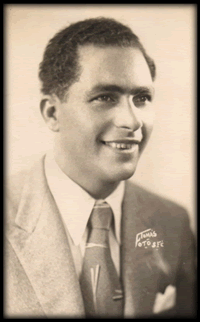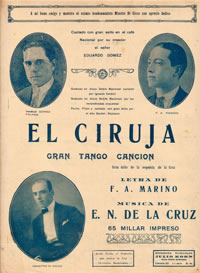By
De la Cruz - Ernesto de la Cruz, from Pacho to Piazzolla

ot only the pleiad of names that have transcended massively have laid the foundations of tango. Since its early days it had its “workers”, anonymous laborers that have left an unquestionable footprint. For that reason, to speak of Ernesto de la Cruz doesn't mean to only refer to the author of “El ciruja.” That he has been recognized for having composed that tango does not invalidate that, at the same time, he has left a lasting oeuvre, not only in compositions, but in performances in theaters and radios of our country in days gone by. For that reason, this bandoneonist born in Concordia, Entre Ríos, on September 8, 1898, is much more than an author.
 «When my father died, in 1908, my mother brought the whole family to Buenos Aires. It is for that reason that everything I did, I did it in the Capital. Never more did I return to Concordia. Nor they ever called me. I worked in a shop, and I didn't know which was the existing musical movement. For that reason, I think that I came closer to tango by chance. On certain occasion, I went to a patio dance with a friend. There was a man there, a heavy drinker, that played the bandoneon. It was an instrument that I ignored completely. Three days later, my partner told me: «Don’t you remember that drunkard? He’s selling his bandoneon.» And I, that had watched him and was surprised because I didn't understand how he made to play so many keys, asked him how much its cost was. «Six pesos.» I bought it. And so I learnt, with a second-hand bandoneon and playing by ear. I took it to be tuned to Mariani’s and I began to study with a plaster worker in the neighborhood of Chacarita, Ángel Fabrizio. That was by the late 1916.
«When my father died, in 1908, my mother brought the whole family to Buenos Aires. It is for that reason that everything I did, I did it in the Capital. Never more did I return to Concordia. Nor they ever called me. I worked in a shop, and I didn't know which was the existing musical movement. For that reason, I think that I came closer to tango by chance. On certain occasion, I went to a patio dance with a friend. There was a man there, a heavy drinker, that played the bandoneon. It was an instrument that I ignored completely. Three days later, my partner told me: «Don’t you remember that drunkard? He’s selling his bandoneon.» And I, that had watched him and was surprised because I didn't understand how he made to play so many keys, asked him how much its cost was. «Six pesos.» I bought it. And so I learnt, with a second-hand bandoneon and playing by ear. I took it to be tuned to Mariani’s and I began to study with a plaster worker in the neighborhood of Chacarita, Ángel Fabrizio. That was by the late 1916.
«And by chance I began to play with my orchestra, also. I had never left Villa Crespo, my neighborhood, and on a certain day I saw a notice saying that an orchestra was requested to work in the German beer shop of the municipal riverside resort. It was 1923, and I don’t know how I formed that orchestra. But the question was that there I began. It didn’t turn out so bad for me because in 1924 I made my debut at the café El Nacional after Pacho’s departure. While working there I realized that I needed to improve my playing. For that reason I studied with Minotto, and also harmony with maestro Gilardo Gilardi. At the beginning the group was lined up by Antonino Cipolla on piano, Teodoro Maidana and Balerio on violins, Carlos Mores on drums, Corletto on double bass, Luis Yankelevich on saxophone and I, on bandoneon. Then there were changes made. In 1925, Di Sarli just arrived from Bahia Blanca, was with me for the whole season. And in 1926 “El ciruja” was born.
«Gilardo Gilardi was finishing an opera, “Urutaú”, which he premiered at the Colón opera house. And as he was with the librettos on the piano, I approached him to ask him what was to be written first, the poetry or the music. Then he told me that in all the cases the poet should write first and the musician later. By that time the café was frequented by the national duo Alfredo Marino-Pablo Gómez. I asked Marino a lyric because I knew that he used to write. Then he brought me a lyric, a lyric in lunfardo that by that time was not common. Gómez put a title to it: “El ciruja.” And he sang it the day of the premiere. It was August 12, 1926. Yes, it was a chance occurrence in the sense that nobody ever imagined the later success.
«I had always been a fan of Pedro Laurenz. But in general, I liked all the greats of that time: Marcucci, Minotto, Maffia.
 «I was only in the De Caro's orchestra, but as a substitute player. That is to say, replacing somebody. Apart from that, I never left my field. With the sole exception, of course, of the radio, where I joined the staff cast. Otherwise, I always kept my groups. And it made me withdraw from show business. Because to put together my groups resulted in awful headaches for me. And I never had a temper to lead. For that reason, after twelve years working on Radio Belgrano, I told Mr. Jaime Yankelevich that I had to quit. I switched to Radio El Mundo because I preferred to be a simple player rather than leading my own orchestra.
«I was only in the De Caro's orchestra, but as a substitute player. That is to say, replacing somebody. Apart from that, I never left my field. With the sole exception, of course, of the radio, where I joined the staff cast. Otherwise, I always kept my groups. And it made me withdraw from show business. Because to put together my groups resulted in awful headaches for me. And I never had a temper to lead. For that reason, after twelve years working on Radio Belgrano, I told Mr. Jaime Yankelevich that I had to quit. I switched to Radio El Mundo because I preferred to be a simple player rather than leading my own orchestra.
«I never managed to record. They didn't give me the opportunity. They promised me to, but nothing happened. Only by 1936, in Odeon, I recorded a waltz and a ranchera with a trio. Nothing else.
«On the radio I began in LOY, located on Boyacá Street, around 1924. Its owner was Manuel Penella. When Jaime Yankelevich bought it, it became Radio Nacional at the beginning, and finally Radio Belgrano. When it moved from Boyacá to Estados Unidos Street, I traveled on the truck of the moving. Until 1937 I was artist for Belgrano. But for the reasons already mentioned, I decided to switch to Radio El Mundo which offered me its staff orchestra. On this radio station, thanks to the program Estampas Porteñas, we made a tour throughout all the provinces. Also when the vocalists were Carlos Acuña and Alba Savino we were part of an event unique in history. During a season, prior to the soccer matches aired by the radio station chain of El Mundo, in each stadium a platform was assembled. And before each match, our orchestra performed there. We were the only ones that made such a thing. Then on radio, while the time of the match was awaited, we appeared live from all the stadiums. In 1961 I retired and I quit the radio. Previously I had worked in the Odeon cabaret in Juan Migliore's orchestra. In my latter times, in the staff orchestra, I had had opportunity to know great musicians like Julio Ahumada, for example.
«I think that I made better things, but the public has determined that it is “El ciruja” my most important work. It was because it was the right time and the café was placed in a suitable location. For that reason it acquired so much importance. I think that there were others with the same level. For example, “Luna pampa”, a folk song that Héctor Artola played at the Teatro Colón with a concert orchestra. Another song that I wrote and that I think that has its value is “Zíngaros”. It, as its title indicates, has a gypsy flavor. And another piece that I have written "seriously" is “Creciente”, an Entre Ríos song that bears lyrics written by Juan Reyes. With about two thousand numbers I wrote, to choose some among them is difficult. But I think that with these numbers is enough.
«Today's bandoneonists have a great speed, a very different technique. And it is exactly due to that technique that sometimes tango is too much distorted. A man that has renewed the gener, a true creator of the instrument, is Astor Piazzolla. I admire him. They criticize him, but he knows about music more than anyone. Also, he doesn't say that he plays tango. He plays Buenos Aires music. He created a style. And everybody, at the present time, is going toward that style.
«Another one that I like is Ernesto Baffa. There are many with good capabilities. They only have a serious problem, and it is that they cannot have personality. It happens because the orchestras don't have the same continuity that at other times. In the past the groups were polishing themselves in the cabarets, at the cinema theaters. Because they performed daily. Now, the two only orchestras that appear regularly are those of José Basso and that of Osvaldo Pugliese. And the latter is pure tango, without having deprived it of its essence. Pugliese is different from all the others: without impairing the other figures of our time, I think that he is the "boom" of today's tango.»
Ernesto de la Cruz died on November 14, 1985.